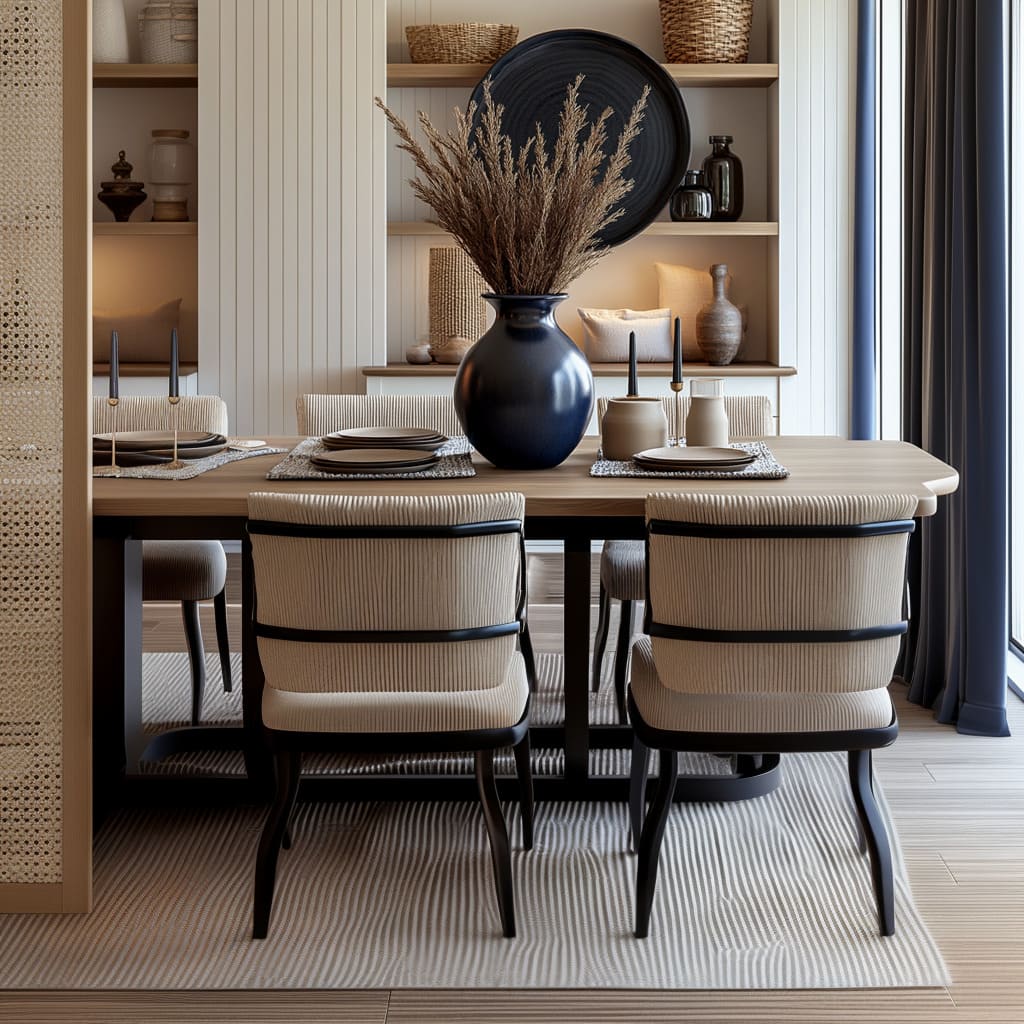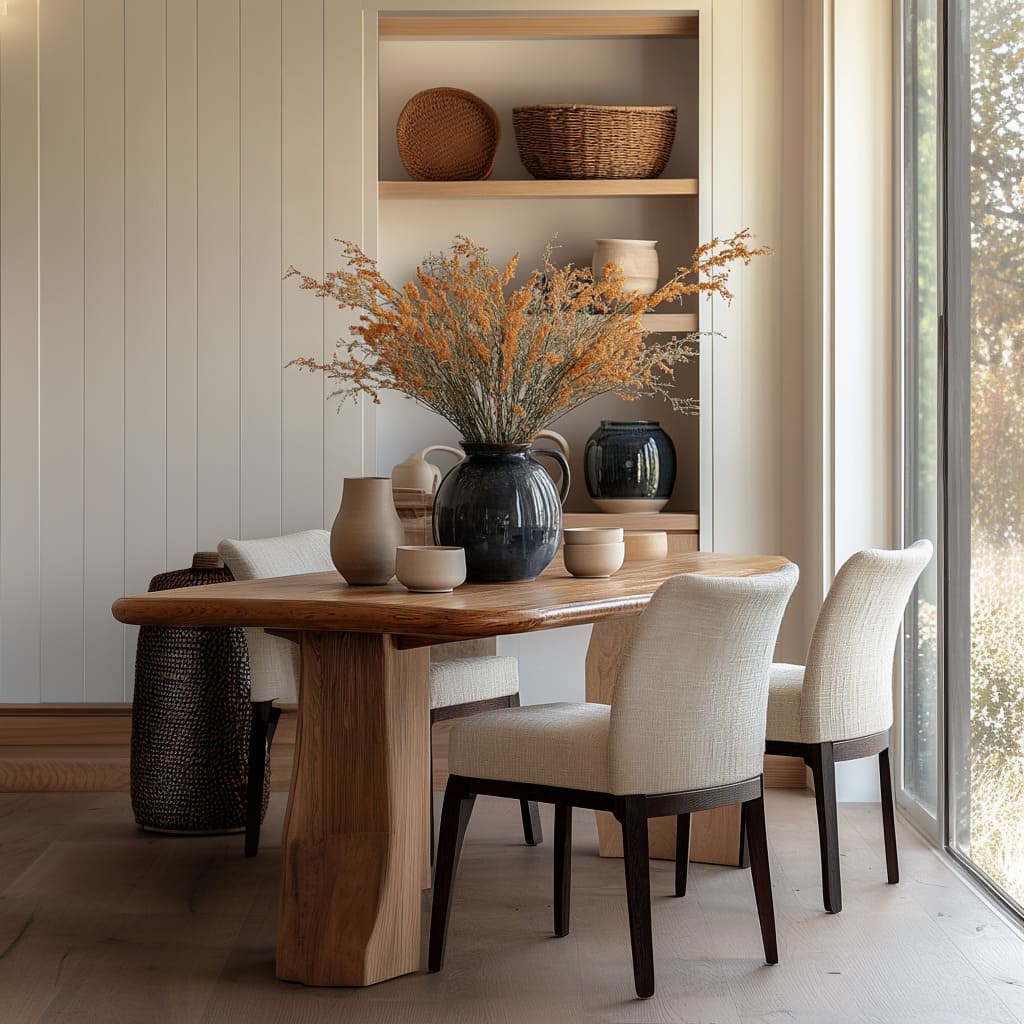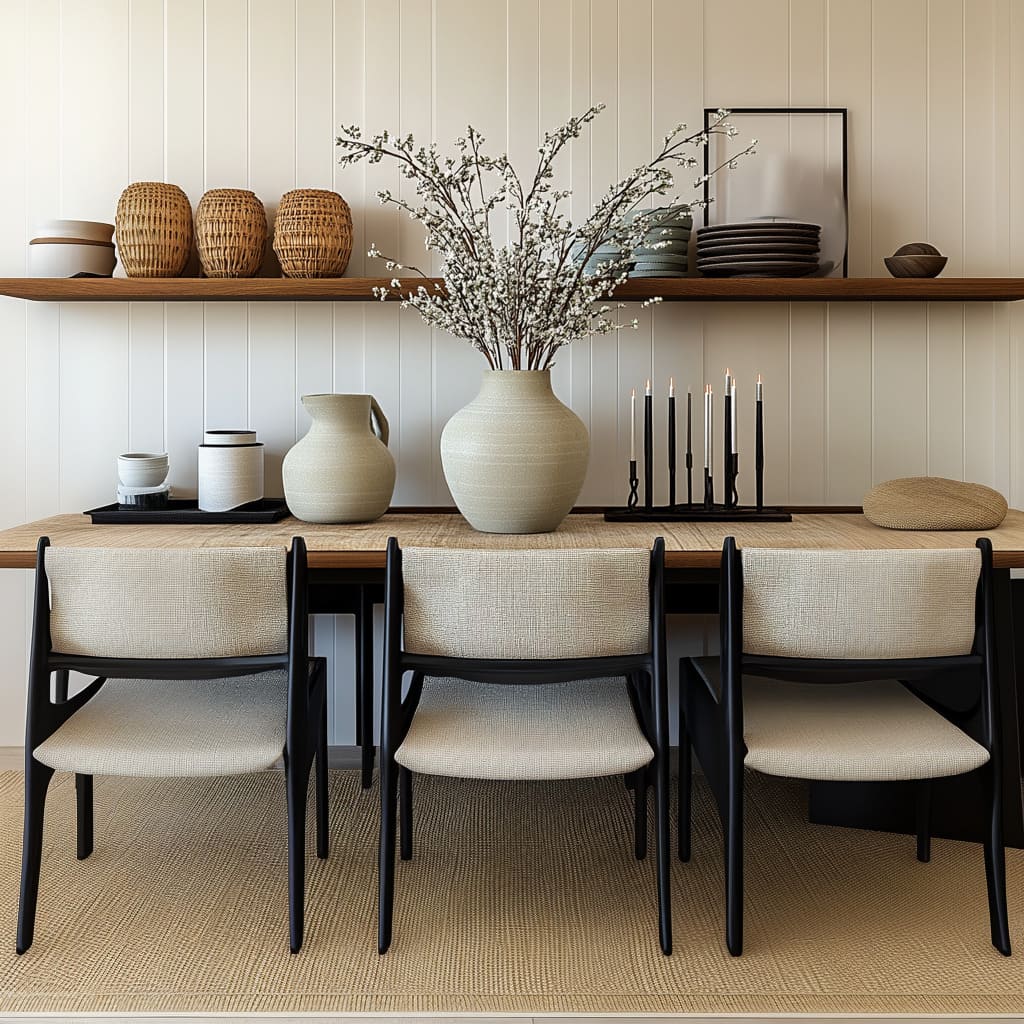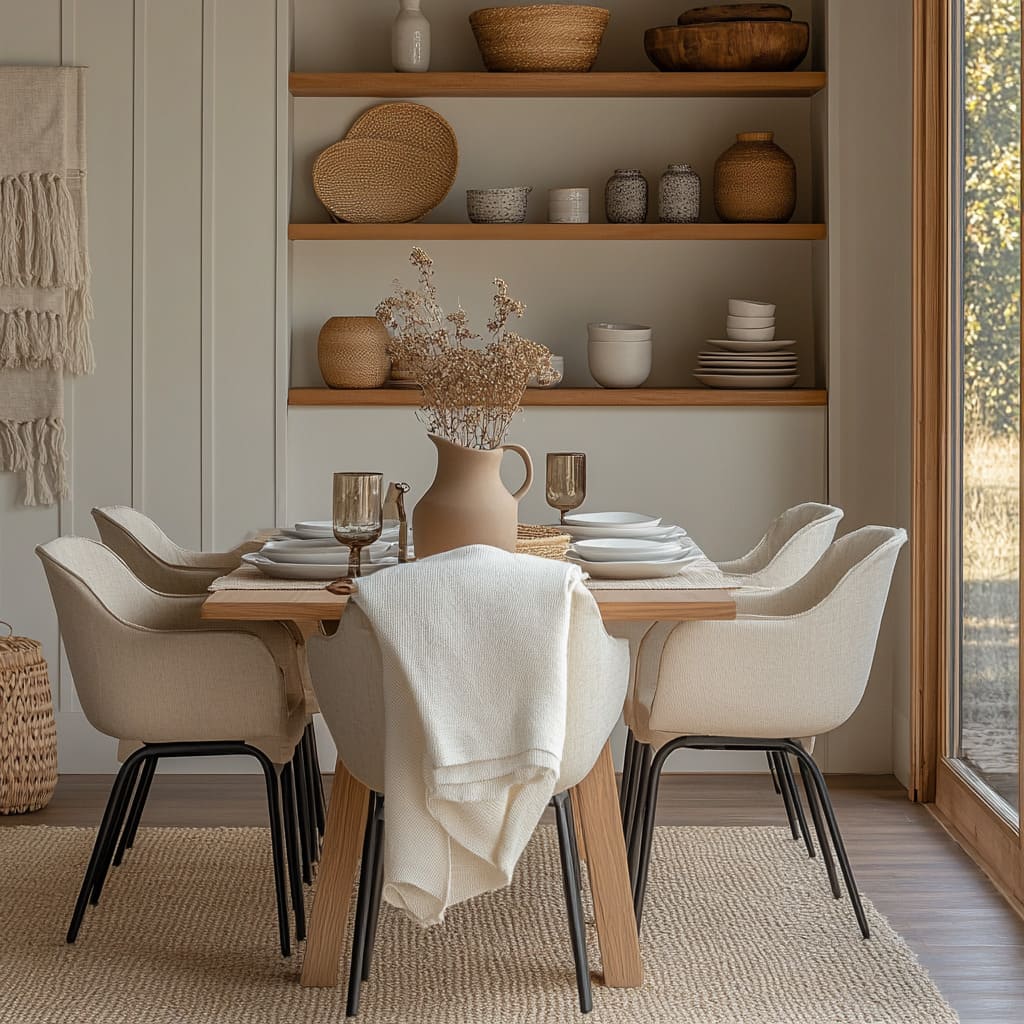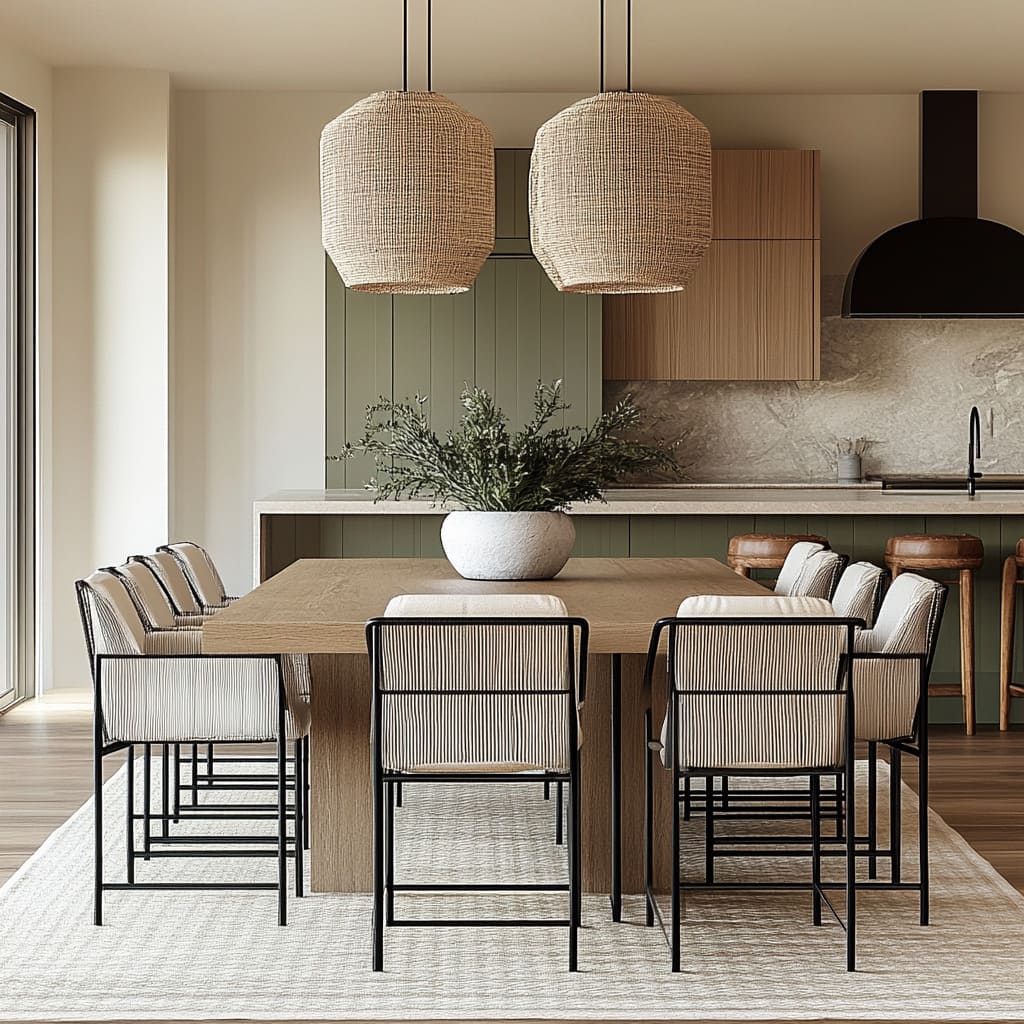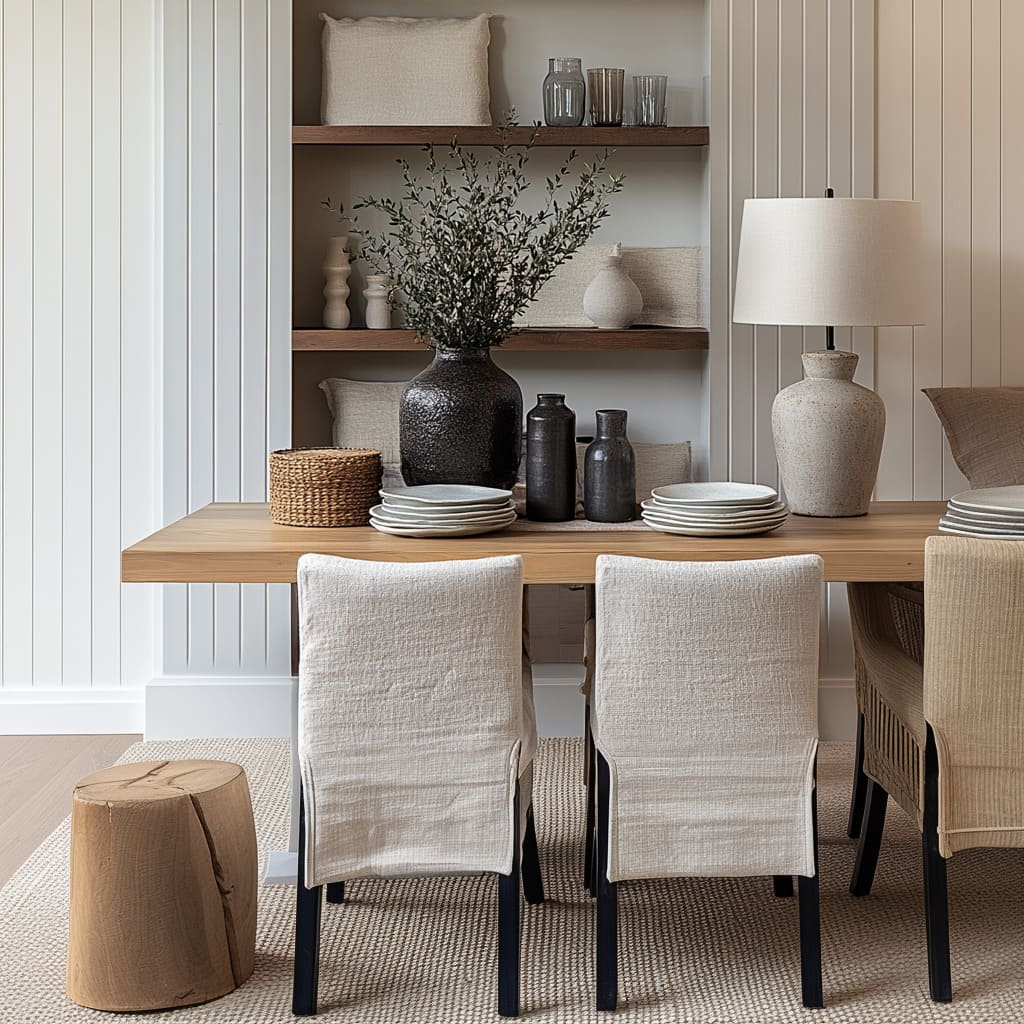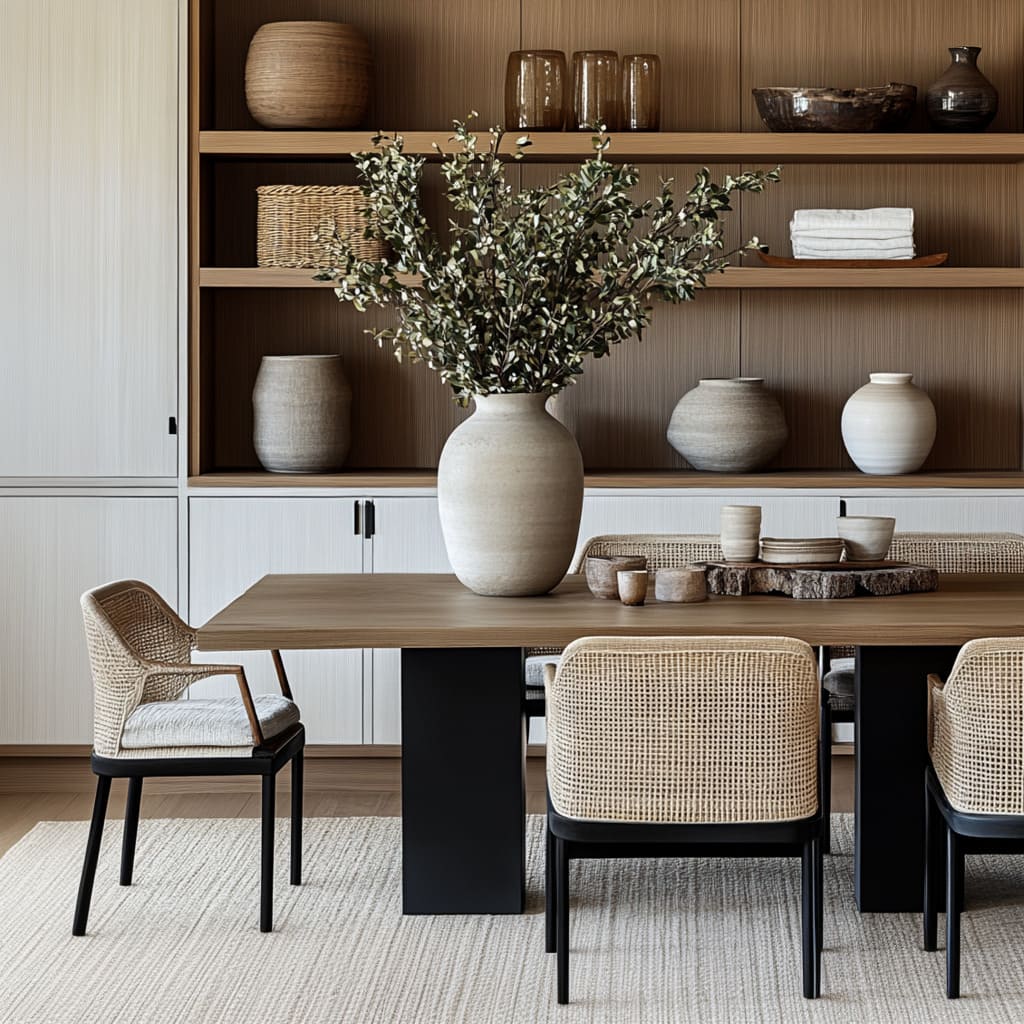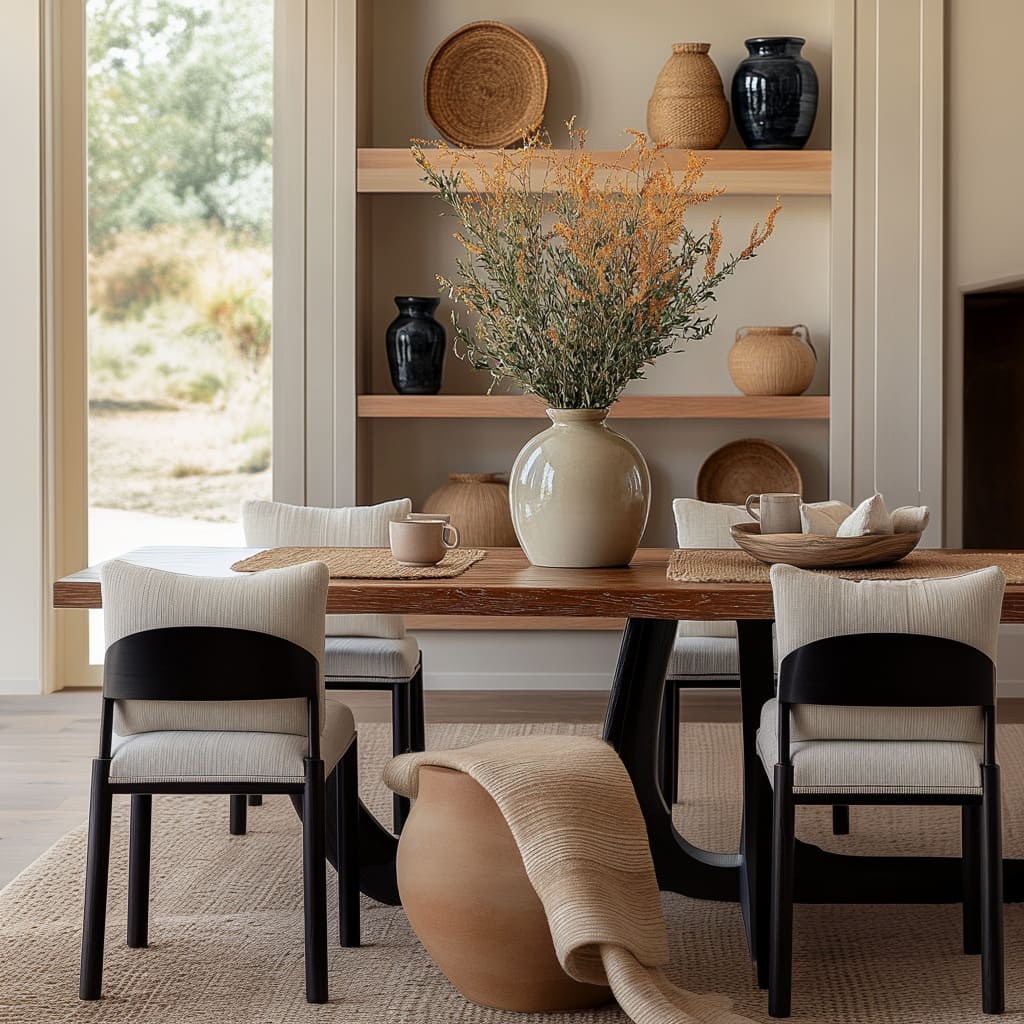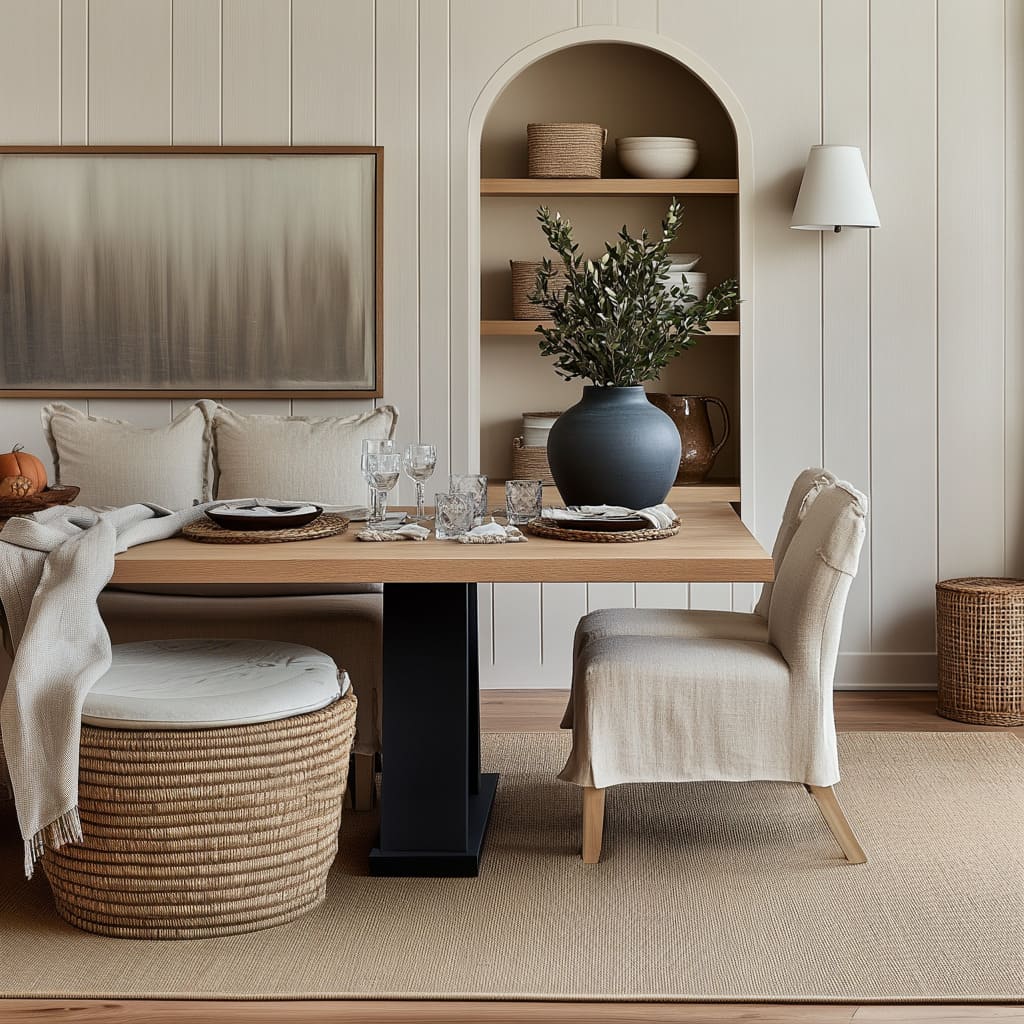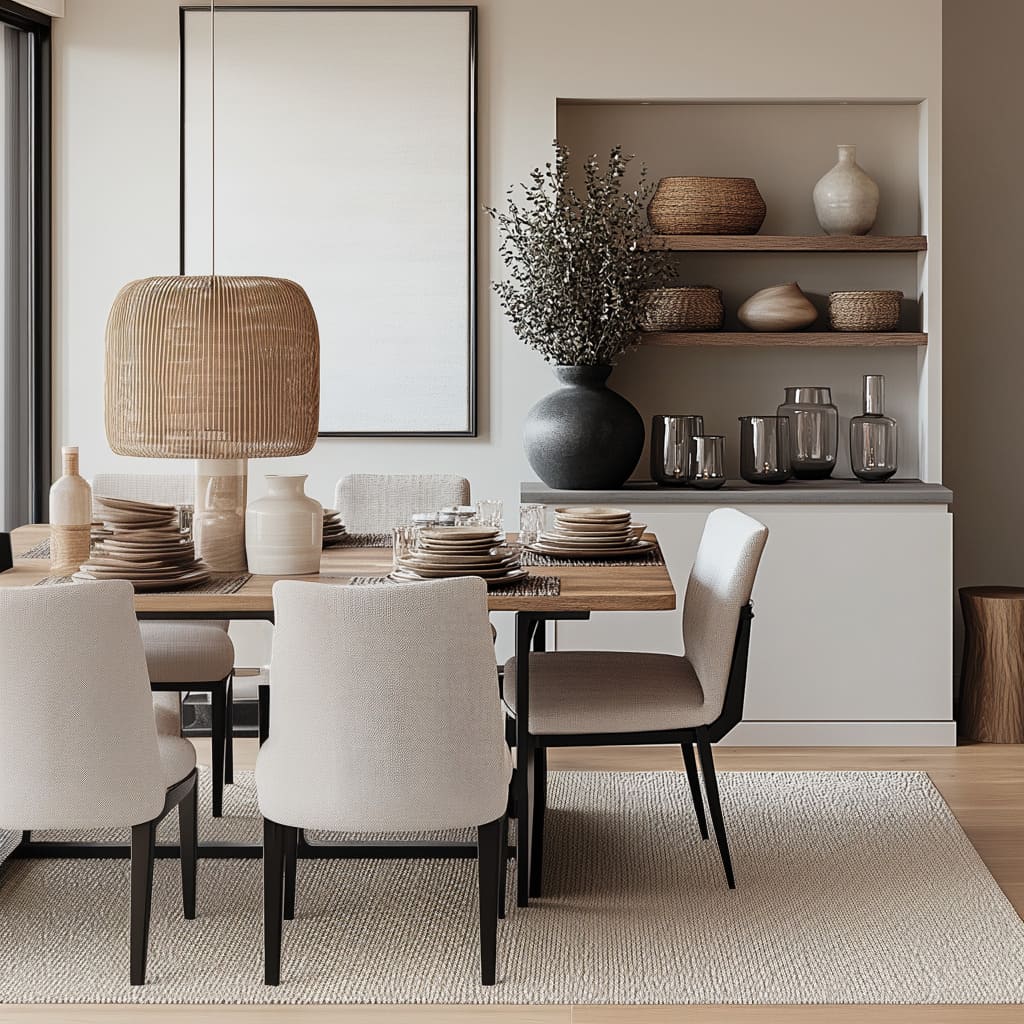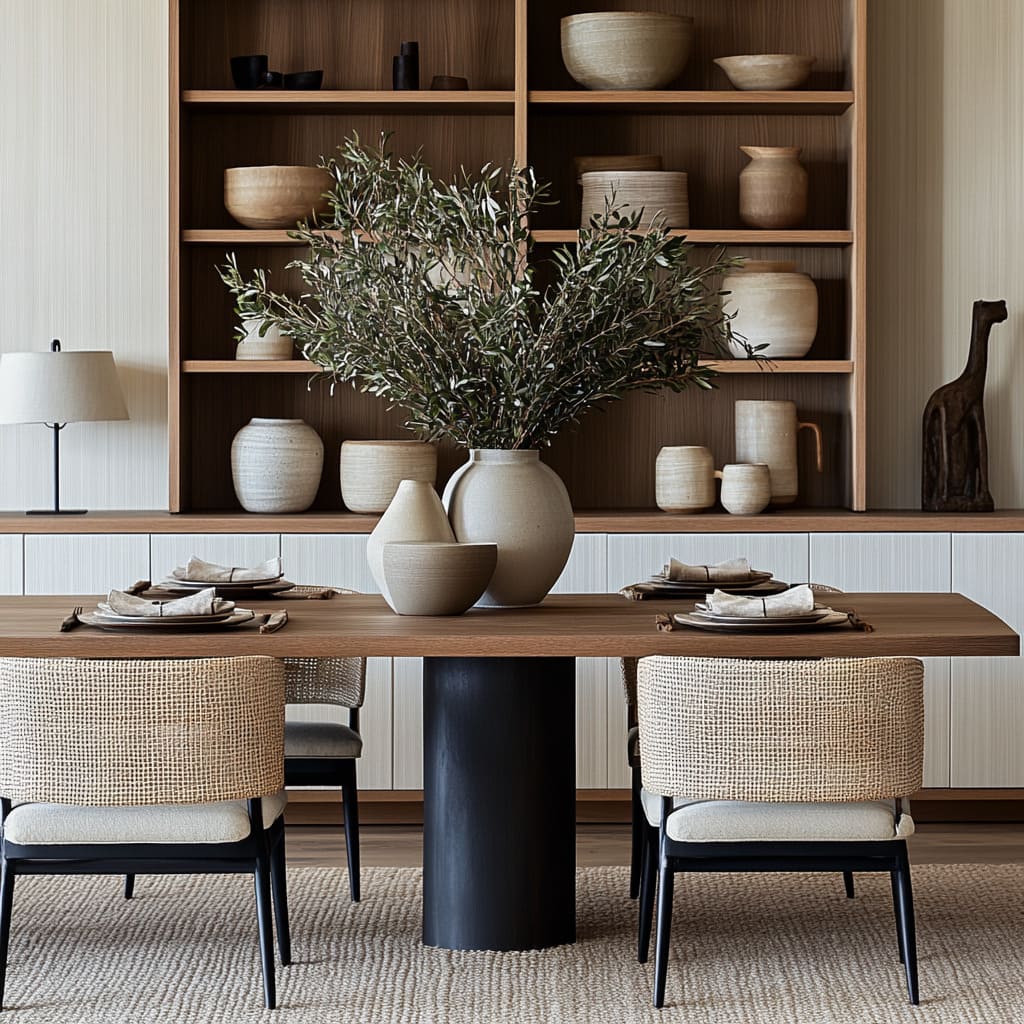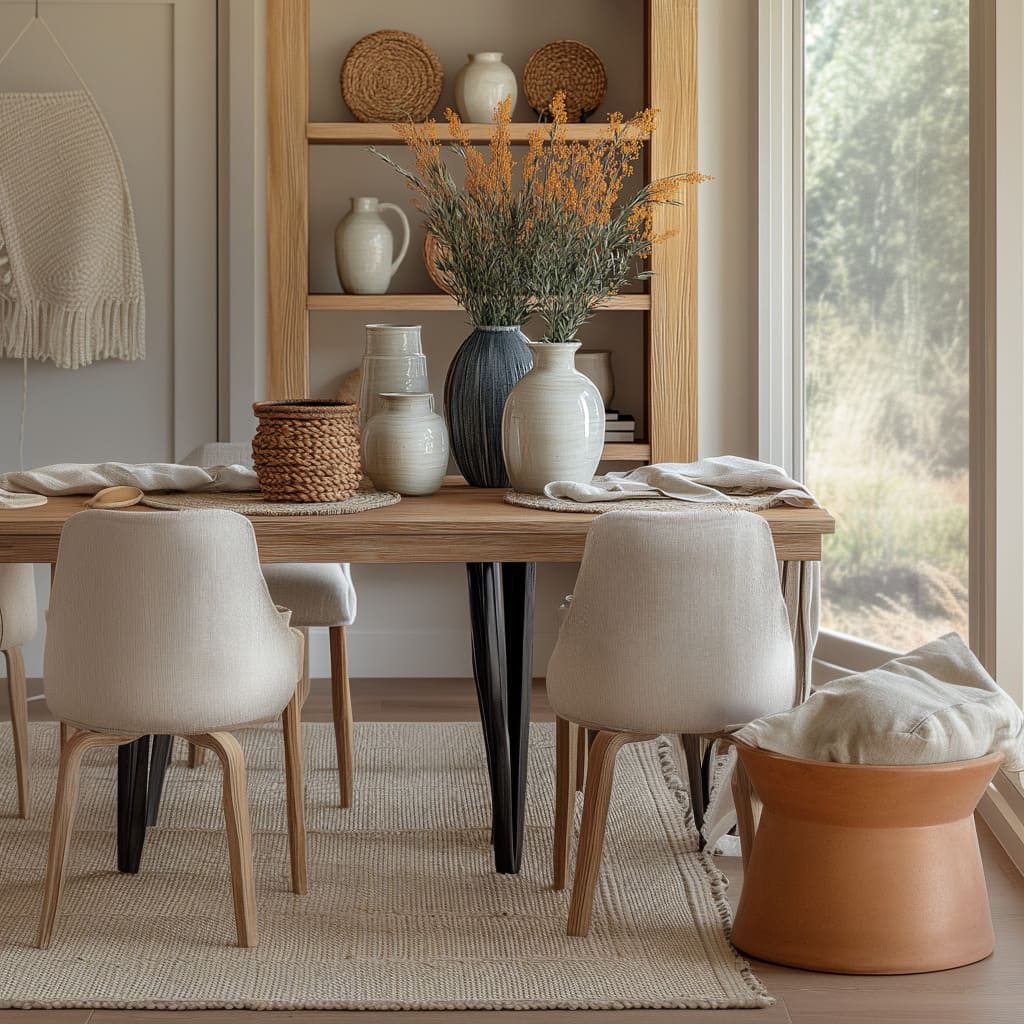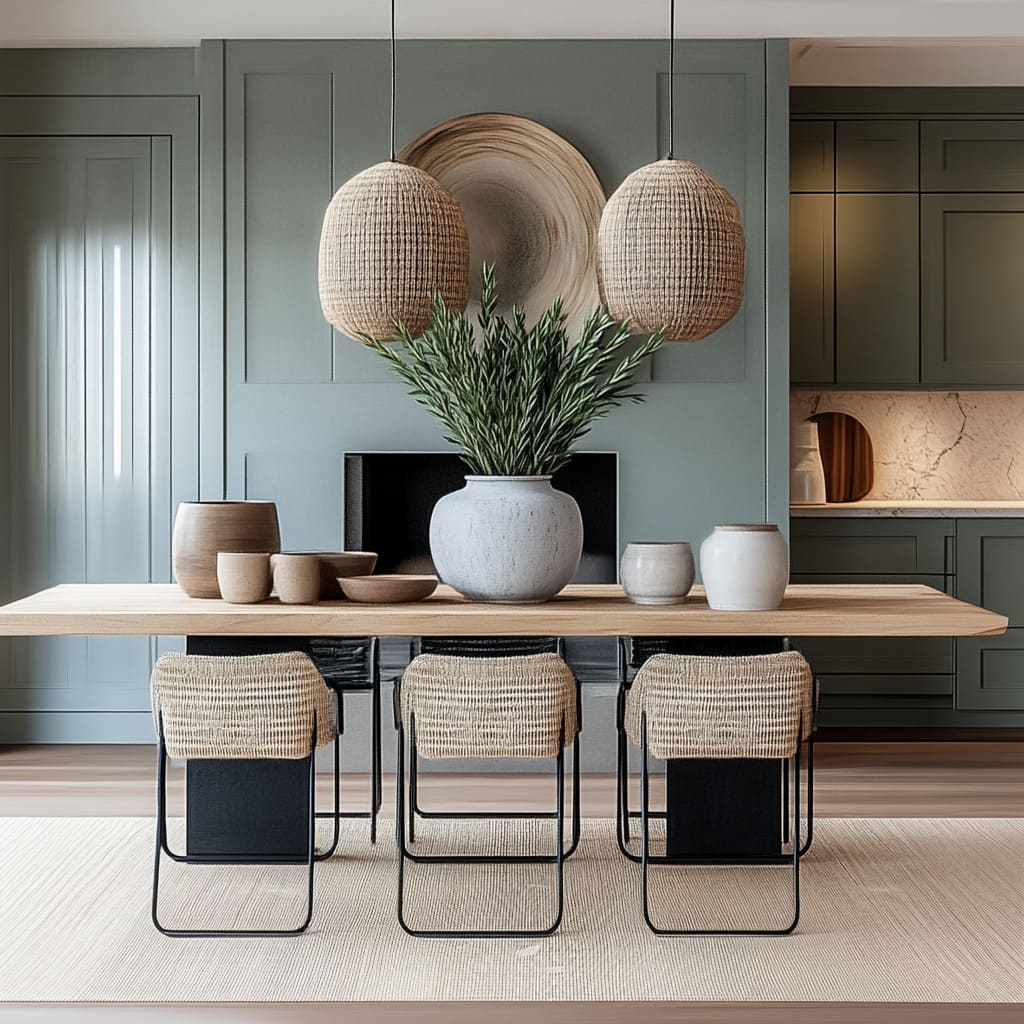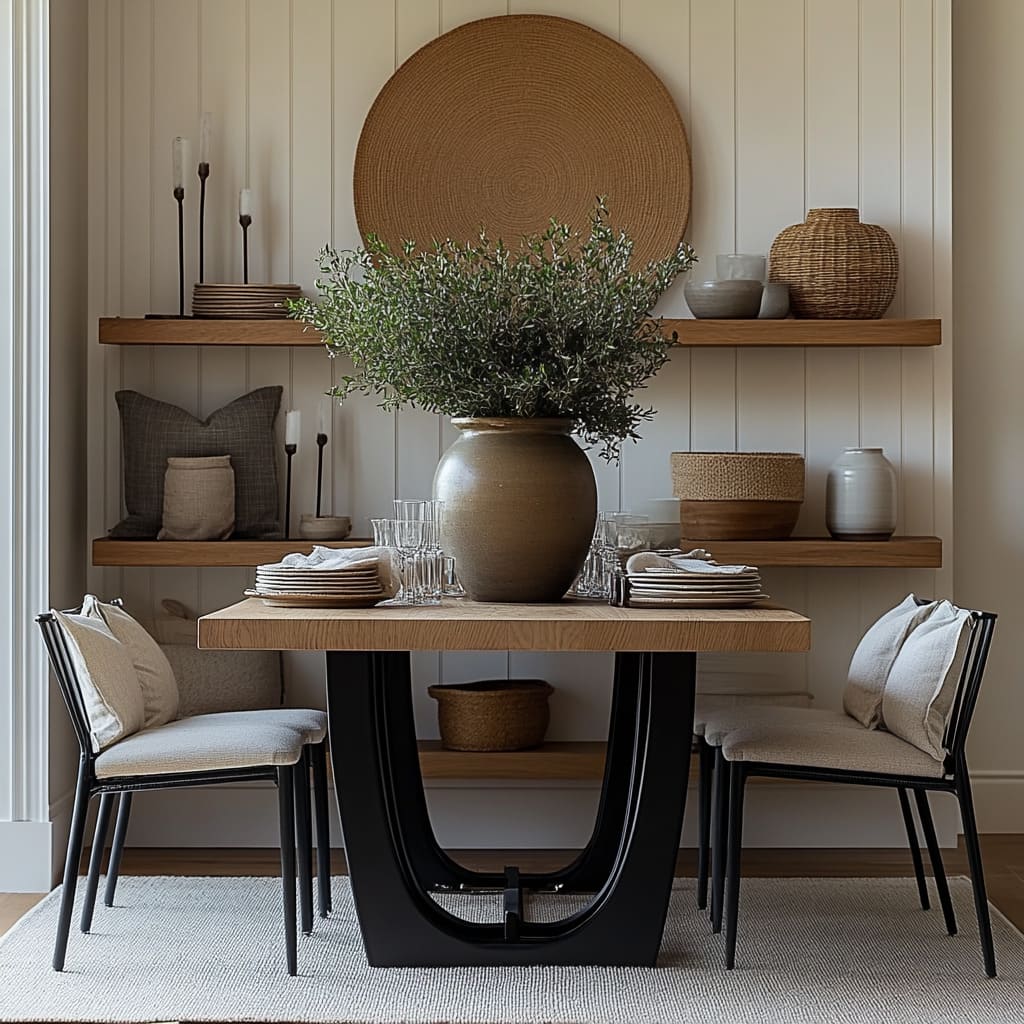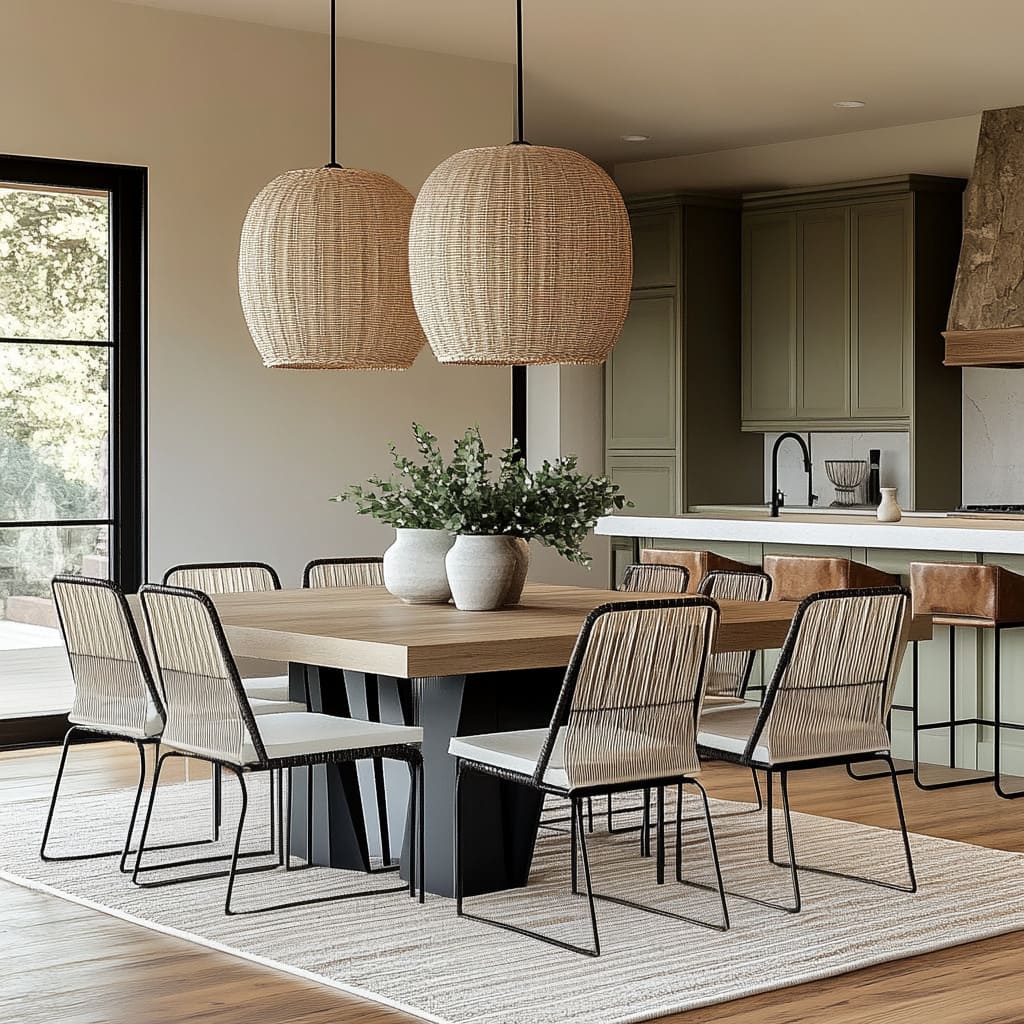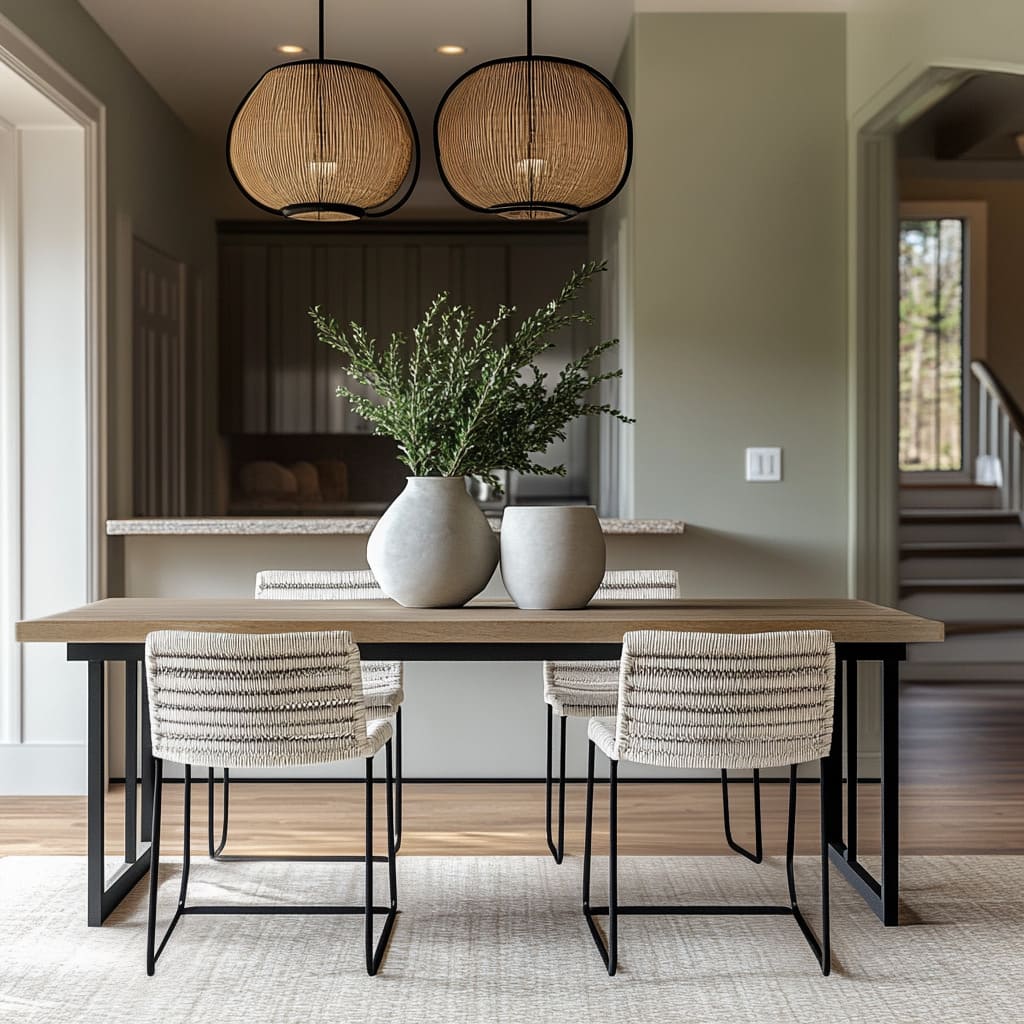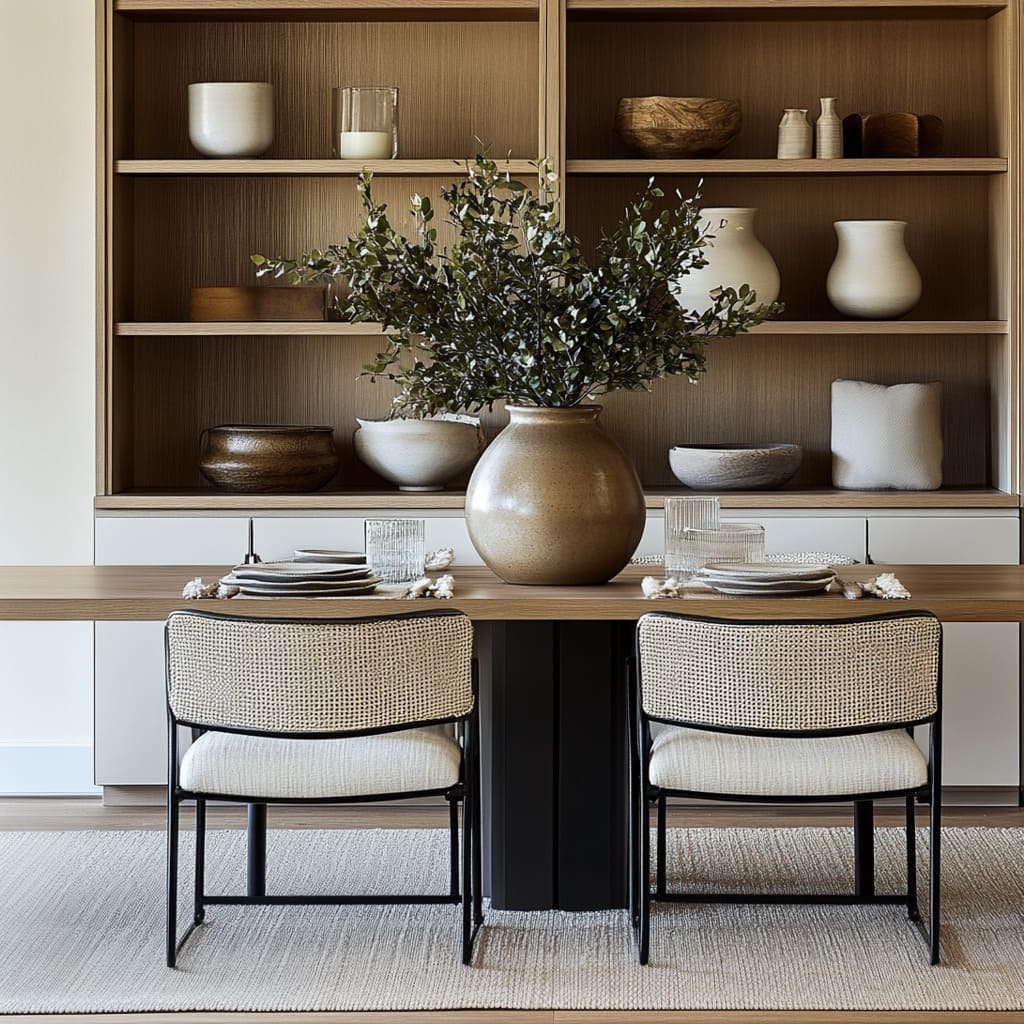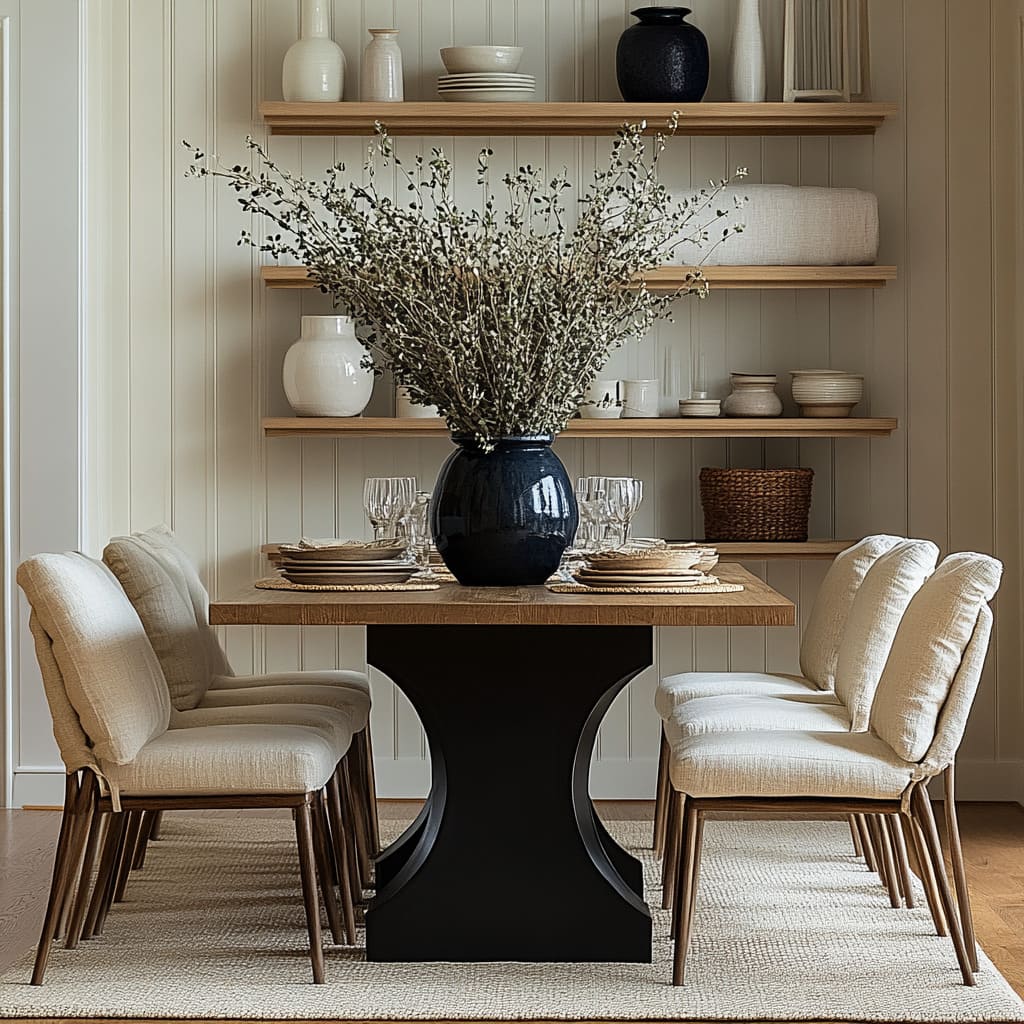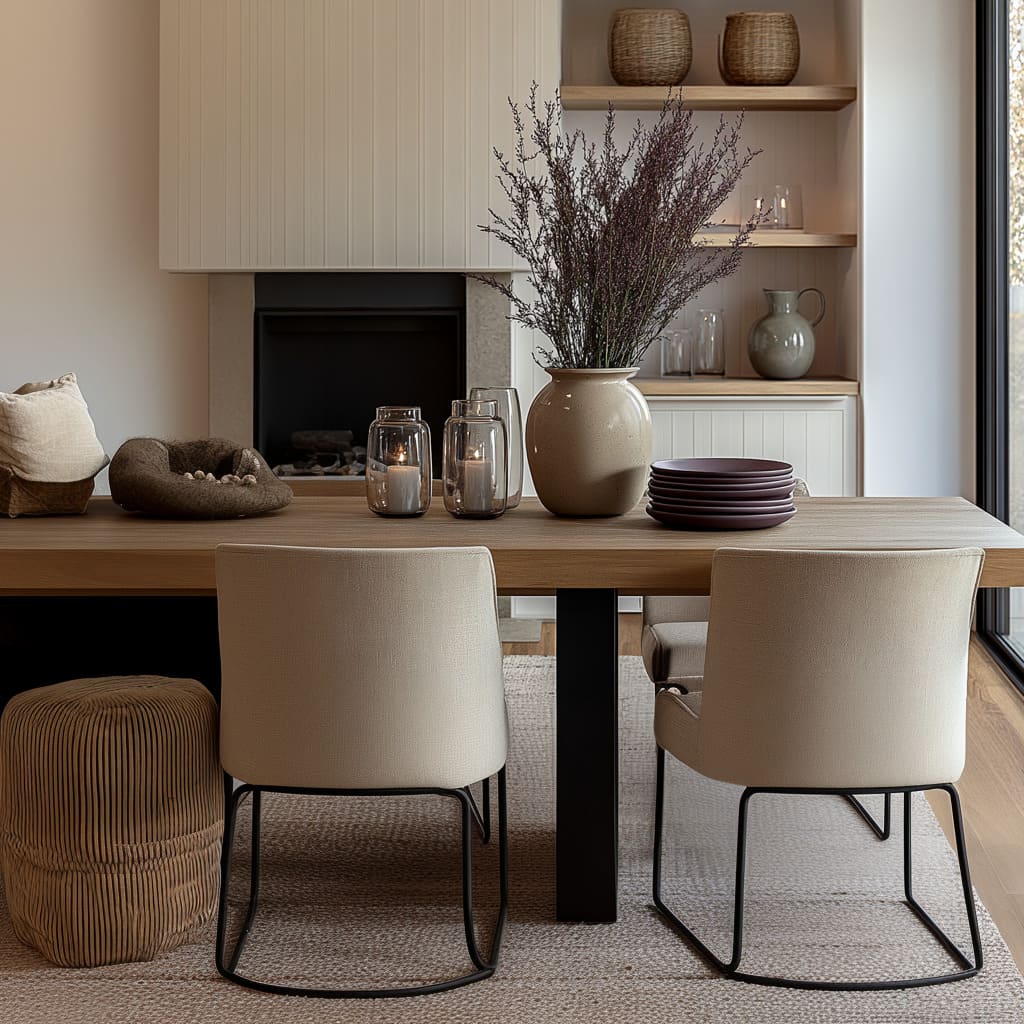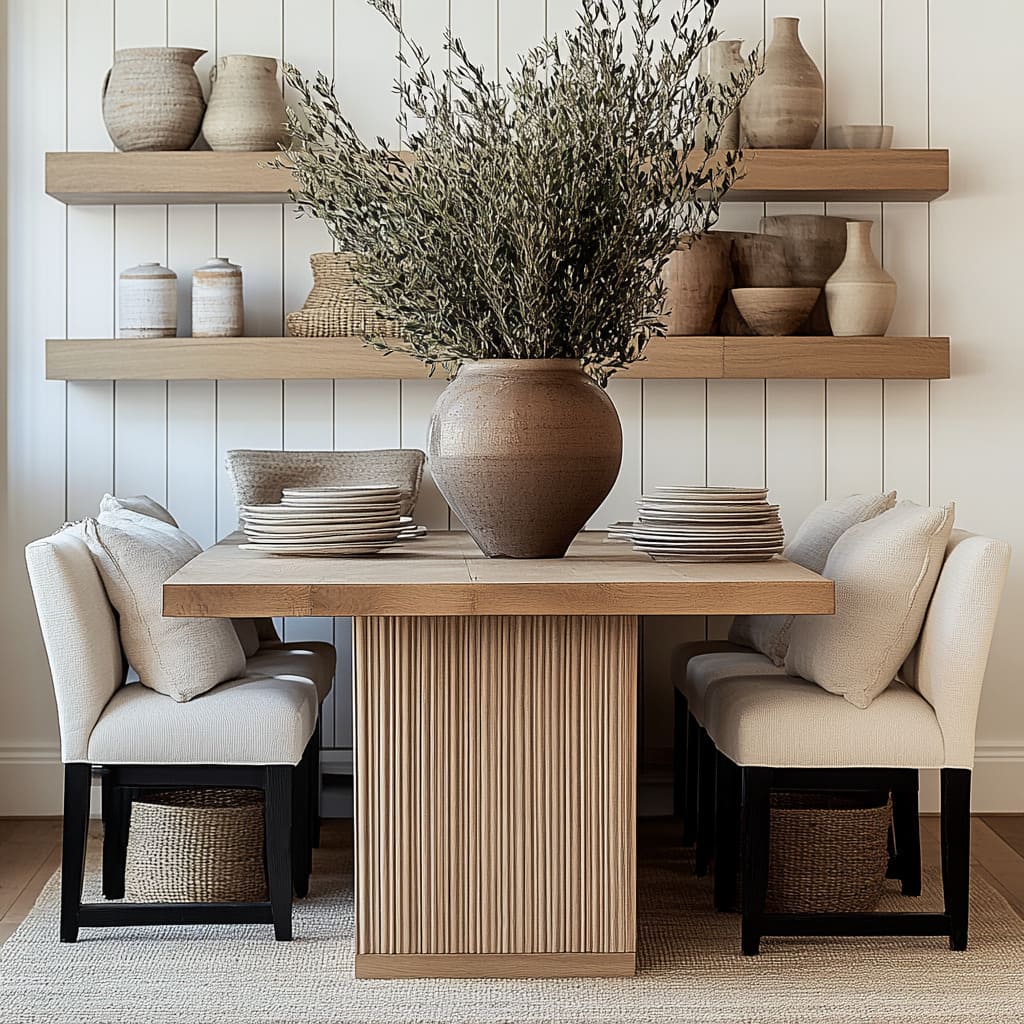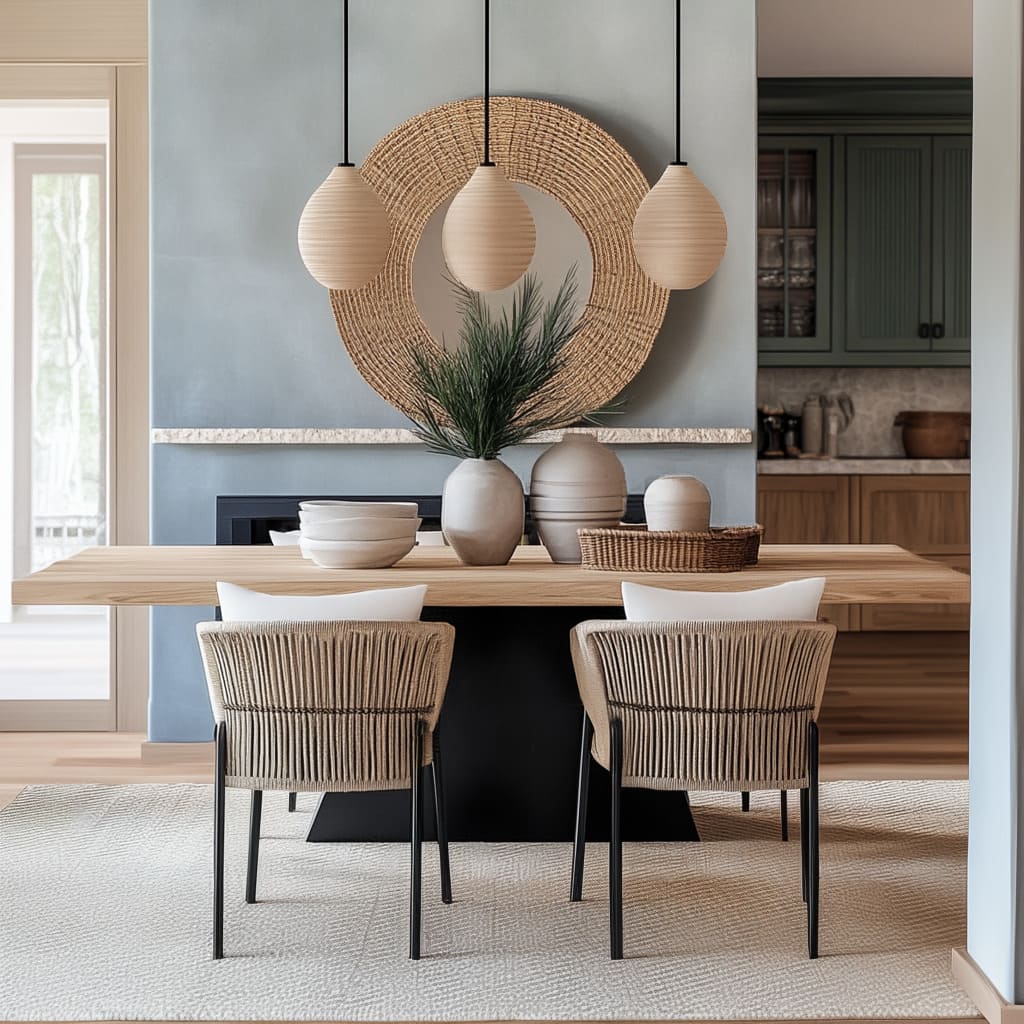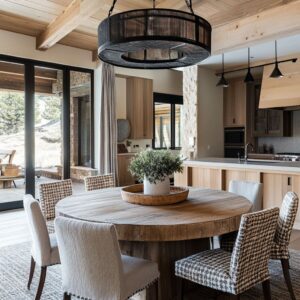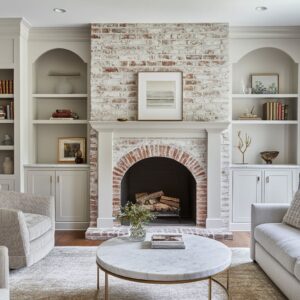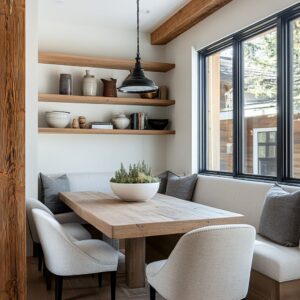Modern farmhouse dining rooms have taken on a fresh life, blending rustic charm with contemporary touches to create spaces that feel warm, inviting, and undeniably stylish. While traditional farmhouse style leans heavily on reclaimed wood, cozy textures, and neutral colors, today’s modern approach isn’t afraid to mix materials, layer finishes, or add subtle hints of other design styles.
Think black metal paired with light wood, woven accents next to sleek ceramics, and upholstered seating alongside statement vases. These unexpected design combinations are what make modern farmhouse dining rooms stand out as the perfect mix of comfort and sophistication.
In this article, we’ll look at the key elements and creative touches that define modern farmhouse dining rooms, from standout furniture pieces to those smaller decor details that tie everything together. By analyzing real-world descriptions of stylish and trendy interiors, this guide will serve as practical inspiration for homeowners looking to create their own perfectly curated farmhouse dining room ideas.
Whether you’re revamping an open-layout space or a cozy dining nook, you’ll find unique tips on combining materials, playing with balance, and adding subtle influences from other design styles to elevate your home’s dining space.
Today’s modern farmhouse dining room isn’t just about replicating rustic spaces of the past—it’s about finding clever ways to make the familiar feel new and personal. From thoughtfully curated shelves to lighting that acts as functional art, the beauty lies in details that blend functionality and style seamlessly.
With this approach, dining rooms become more than just places to eat—they become the heart of the home, where design and purpose meet. This guide dives deep into the design features, finishes, and decor elements that shape the modern farmhouse dining room aesthetic, giving you practical takeaways and fresh ideas for creating a stylish, cozy, and functional dining space in your own home.
Common and Specific Features in Modern Farmhouse Dining Rooms
Furniture Pieces and Layout
Dominant Features
At the heart of most modern farmhouse dining rooms is a large wooden dining table. Often showcasing natural or live-edge finishes, these tables create a strong focal point that anchors the space with their organic texture and sturdy presence.
The table’s surface frequently highlights wood grain, making it feel warm and natural, while contrasting legs—such as sleek black metal or darker-toned wood—add a refined, contemporary edge to the rustic design. This combination bridges farmhouse charm with modern simplicity and elevates the visual appeal of the entire dining area.
Seating choices lean toward upholstered dining chairs in soft, neutral shades like beige, cream, or light grey. These chairs introduce a sense of coziness and offer a smooth contrast to the rugged texture of the wooden table.
Curved edges and streamlined silhouettes are common, enhancing the modern aesthetic while maintaining farmhouse warmth. Adding variety, occasional woven or wicker chairs make appearances, introducing a textured, organic look that complements the natural tones of the table.
This mix prevents the space from looking overly uniform and injects character into the arrangement.
Patterns in Arrangement
The arrangement of furniture in modern farmhouse dining rooms emphasizes balance and comfort. Symmetrical placement of chairs around the table is a recurring pattern, creating a tidy and visually calming look.
This symmetry often extends to other elements in the space, such as evenly spaced decorative pieces on shelves or lighting fixtures above the table. In some designs, benches make their way into the layout, often on one or both sides of the table.
These benches offer functional seating while contributing to a relaxed, communal atmosphere—ideal for families or casual gatherings. They can be paired with upholstered chairs on the ends, adding dimension and avoiding monotony in the setup.
Thoughtful Tips
To keep the space visually dynamic, many modern farmhouse dining room ideas incorporate a thoughtful mix of high-backed upholstered chairs with lower-profile seating like woven or wooden stools. This variation in height and form avoids a flat, predictable look, making the space feel curated and layered.
Functional accent pieces like small stools or woven baskets are commonly placed nearby. These elements contribute to both style and practicality, offering additional seating, storage, or decorative opportunities without cluttering the room.
Small woven stools can double as decor beneath open shelving, while baskets neatly house linens or dining accessories.
Key Insights for Modern Farmhouse Dining Rooms
The beauty of modern farmhouse dining spaces lies in their balance of rustic tradition and modern sensibility. Pairing a farmhouse dining table and chairs with subtle contemporary accents—such as metal, neutral upholstery, and woven textures—results in rooms that feel both familiar and fresh.
Thoughtful combinations like upholstered chairs next to wicker or bench seating, or live-edge tables paired with minimalist black metal legs, give the space depth and individuality. These dining rooms thrive on harmony but not uniformity.
Visual interest comes from subtle variations in materials and form, ensuring the space feels well-rounded but not overly predictable. The use of functional yet decorative items, such as stools or baskets, further ties together style and utility, reinforcing the modern farmhouse ideal of blending beauty with everyday practicality.
When combined thoughtfully, these elements turn the dining area into a space that feels cohesive, warm, and effortlessly stylish. The mix of classic farmhouse charm with modern touches is what makes this design style resonate so strongly in homes today.
It’s not about recreating the past—it’s about bringing timeless style into the present with fresh, purposeful ideas.
Materials and Finishes
Material Combinations
Modern farmhouse dining rooms rely heavily on a mix of natural and organic materials, creating interiors that feel grounded, functional, and refined. Wood remains the cornerstone of these spaces, seen in dining tables, shelving, and flooring.
The finishes vary to balance rustic character with contemporary style. For instance, natural or untreated wood brings out raw beauty, while light-stained or live-edge options add subtle texture and individuality.
These wooden surfaces feel familiar yet sophisticated, making them the perfect centerpiece of the dining room. To contrast the warmth of wood, metal accents play a supporting role.
Black metal legs on dining tables or chairs act as a modern counterpoint, sharpening the overall look without overpowering the farmhouse charm. You’ll often see these industrial touches echoed in light fixtures like pendant lamps or chandeliers, tying the space together with clean, linear silhouettes.
The mix of wood and metal not only modernizes the dining area but also highlights the versatility of farmhouse dining ideas when it comes to material combinations. Textiles complete the picture, softening the sturdiness of wood and metal.
Upholstered chairs, typically dressed in light linen or soft cotton, bring comfort and subtle color to the dining setup. Neutral hues like cream, beige, or light grey dominate, giving the space an airy and relaxed feel.
To anchor the dining area, rugs made of chunky jute or woven natural fibers often take center stage beneath the table. These textured additions add both visual warmth and practicality, complementing the natural palette of the room.
Finally, ceramics and glass add a refined, artisanal quality to the space. Simple, well-crafted vases, pitchers, and decorative glassware serve as understated centerpieces or table decor.
Their smooth surfaces contrast with the organic feel of wood and textiles, offering a subtle touch of elegance that balances the rustic elements.
Wall, Ceiling, and Floor Finishes
Walls in modern farmhouse dining rooms often showcase vertical paneling—shiplap or beadboard being two standout favorites. These subtle textures reinforce the farmhouse character while keeping the overall look clean and understated.
Soft neutral paint tones—like whites, creams, and muted grays—are frequently chosen to create a light, airy backdrop. This allows the furniture and decor to take center stage without overwhelming the room.
The ceilings are typically kept minimal, further emphasizing simplicity. However, subtle accents like exposed wooden beams can sometimes make an appearance, adding warmth and texture to the space.
Pendant lights or woven chandeliers are common choices for ceiling decor, offering both function and style. By keeping the ceiling free from excess details, the focus naturally shifts to the furniture and lighting below.
For flooring, light hardwood or wide-plank wood finishes dominate, reinforcing the natural, inviting feel of the dining room. This choice not only adds warmth but also makes the room appear more open and spacious.
To soften these hard surfaces, jute or woven rugs are almost always layered under the table, grounding the furniture while introducing additional texture. These rugs blend seamlessly with the overall aesthetic and make the space feel more comfortable and functional.
Not-Trivial Insights
The thoughtful contrast between organic materials like wood and jute with sharper metal accents is a defining feature of modern farmhouse dining rooms. This pairing avoids the overly rustic look while maintaining the authenticity of farmhouse style.
Black metal legs or industrial-style lighting fixtures juxtapose beautifully with soft, natural textures, providing a subtle modern edge to the otherwise relaxed space. Another standout combination is the mix of raw and smooth surfaces.
For example, a live-edge farmhouse table paired with upholstered chairs creates visual interest without adding unnecessary complexity. This balance between rugged wood and soft fabrics highlights both comfort and design while ensuring the room feels layered and intentional.
Texture plays a starring role in many modern farmhouse dining room decorating ideas. Woven or wicker seating paired with chunky natural-fiber rugs emphasizes the tactile quality of the space.
Even small details like a woven basket or ceramic vase enhance the material palette, blending traditional farmhouse elements with modern finishes. Overall, modern farmhouse dining rooms shine because of their ability to combine contrasting elements—rough and smooth, rustic and modern—into a cohesive, inviting space.
These material combinations prove that the farmhouse style doesn’t have to be predictable. Instead, it can be versatile, stylish, and perfectly suited for today’s homes.
Decorative Elements and Their Significance
Large Focal Decor
The modern farmhouse dining room style often relies on oversized centerpieces to create a strong focal point. Tall vases filled with dried florals, such as pampas grass, wild branches, or delicate stems, dominate the center of large dining tables.
These natural arrangements add vertical interest and a subtle organic touch, ensuring the space feels alive and cohesive without overwhelming its simplicity. The natural tones in these dried florals harmonize with the warm, earthy palette of the room, tying together the rustic and modern influences.
Another recurring trend is the use of dark ceramic or matte-glazed vases as bold, contrasting focal points. Against lighter wooden tables or neutral-painted walls, these darker elements offer a grounding effect, preventing the space from feeling flat.
Their placement on the dining table, sideboards, or shelves balances visual weight and adds sophistication to the room. These centerpieces, while large, are carefully selected to avoid clutter, allowing the room’s airy and open layout to remain intact.
The oversized decor doesn’t stop at tables—built-in shelves and console tables frequently feature one or two standout pieces, such as large woven baskets or oversized pottery. These larger items anchor the space, while smaller items complement it, creating a sense of curated intention.
Layering Smaller Decor
Layering smaller decorative elements is another critical feature of modern farmhouse dining rooms, contributing to their curated and thoughtful aesthetic. Shelves, tables, and built-ins are often adorned with an assortment of ceramics, such as pitchers, bowls, and plates.
These pieces, usually handmade or artisanal in appearance, introduce texture and subtle charm. When layered in varying heights or arranged as clusters, they create visual interest without feeling too calculated.
Woven baskets are another staple, often tucked under tables, placed on shelves, or used as decor in their own right. They add warmth, texture, and a sense of practicality.
Functionality meets style with these elements, as baskets can easily double as storage for extra linens or dining essentials. The repeated use of natural fibers complements the wooden furniture and soft textiles, making them a natural fit for the overall design.
Candles and lanterns (whether metal, glass, or ceramic) bring an additional layer of warmth and ambiance. Positioned on dining tables, shelves, or along console surfaces, they create pockets of coziness while providing soft, atmospheric lighting.
These smaller decor pieces ensure the room feels lived-in and inviting rather than overly staged.
Wall Decor
Walls in modern farmhouse dining rooms are rarely left bare but are thoughtfully decorated to maintain simplicity while adding character. Minimalistic art pieces, often featuring soft abstract designs or nature-inspired motifs, are popular choices.
These works of art add a layer of refinement and personality without drawing too much attention. One standout feature is the clever use of arched shelves or built-in niches, which serve as natural framing devices for curated decor.
These architectural elements not only provide functional storage but also act as display zones for smaller decorative items like pottery, woven baskets, or vases. The arches soften the room’s overall look, counteracting the more angular lines of furniture and adding a hint of timeless charm.
In some spaces, wooden wall accents, like vertical shiplap or beadboard, act as wall decor themselves. These subtle textures add visual depth while contributing to the farmhouse style without requiring additional ornamentation.
This minimal approach keeps the focus on furniture and larger decorative pieces, ensuring the room feels balanced and cohesive.
Creative Ways to Enhance Your Dining Room
One standout technique in modern farmhouse dining room ideas is the use of oversized centerpieces to complement large wooden dining tables. Without these focal points, tables might feel stark or empty.
By incorporating tall vases with dried florals or branches, the vertical space above the table becomes visually engaging. Another creative design strategy is the recurring mix of dark ceramics against light backgrounds.
Whether on shelves, tables, or as standalone pieces, these darker accents create a sophisticated contrast without overpowering the neutral palette. This small yet significant detail ensures the dining room feels modern and intentional, balancing rustic charm with a sleek finish.
Functionality plays an equally important role, as seen in the thoughtful use of woven baskets and textiles. These elements enhance the farmhouse aesthetic while keeping the space practical.
Storage baskets tucked neatly under tables or on shelves ensure functionality never compromises style. Similarly, decorative throws placed over chairs or benches add softness while providing warmth when needed.
The artful combination of textures, such as woven rugs, chunky ceramics, and linen upholstery, adds layers of comfort and dimension to the space. These layers make the dining room feel visually engaging and lived-in.
By thoughtfully mixing these elements, modern farmhouse dining rooms achieve the perfect balance between casual comfort and curated style, offering endless inspiration for today’s homes.
Lighting Trends and Functionality
Lighting Fixtures
Lighting plays a defining role in modern farmhouse dining rooms, combining both function and visual appeal. Pendant lights are by far the most popular lighting choice for this style.
Often hung as double or triple arrangements over the dining table, these fixtures ensure proportional balance and create a cohesive, symmetrical look. Their designs feature natural materials such as woven rattan, wicker, or seagrass, reinforcing the organic textures that are central to modern farmhouse interiors.
The natural tones of woven pendants beautifully complement wooden tables, jute rugs, and neutral-colored upholstery. These materials allow the fixtures to act as functional lighting while doubling as decorative focal points that elevate the room’s aesthetic.
On the other hand, metal pendant shades—typically black or dark bronze—add modern contrast, breaking up the lighter palette and infusing a touch of industrial flair. This clever mix of materials creates visual interest and ensures the lighting fixtures contribute to both style and practicality.
Woven pendants, in particular, are notable for their sculptural quality. When illuminated, they cast soft, intricate shadows on surrounding surfaces, enhancing the room’s warmth and texture.
This dual purpose—function and decor—ensures that lighting remains integral to the farmhouse dining room’s visual balance, aligning utility with thoughtful design. For those seeking farmhouse dining room light ideas, pendant lighting remains a timeless and versatile solution that can adapt to various interpretations of the style.
Natural Light
Modern farmhouse dining rooms embrace natural light as a key design element. Large windows—sometimes spanning from floor to ceiling—are frequently featured, ensuring an open, airy atmosphere.
These expansive windows are often paired with lightweight, sheer curtains or linen drapes. This allows sunlight to filter through while maintaining a soft, diffused glow that enhances the natural textures and tones within the space.
By letting in ample natural light, the room feels more connected to its surroundings, especially in homes where greenery or scenic outdoor views are visible. This connection to nature aligns with the farmhouse ethos of simplicity, comfort, and organic living.
Large windows also accentuate the carefully selected materials, such as warm wood finishes, matte ceramics, and textured rugs, making their tactile qualities more noticeable. Additionally, natural light works seamlessly with the subtle, neutral color palettes common in modern farmhouse spaces.
Whites, creams, and earthy hues reflect light beautifully, ensuring the room feels inviting throughout the day. For those inspired by cottage dining room ideas, incorporating abundant natural light creates a sense of coziness and authenticity that perfectly suits farmhouse interiors.
One of the most interesting aspects of lighting in modern farmhouse dining rooms is the versatility of woven pendant lights. These fixtures do more than illuminate—they serve as sculptural pieces that anchor the dining table while echoing the room’s natural materials.
The texture and tones of woven pendants tie into other organic elements, such as wooden tables and jute rugs, reinforcing a unified design.
Another important observation is how natural light enhances the visual impact of materials. When sunlight hits live-edge tables, woven seating, or ceramic vases, it emphasizes their raw, organic beauty.
Textures become more pronounced, from the grain of the wood to the intricate weaves of baskets and fabrics. This interplay of light and material ensures the dining room feels layered, warm, and effortlessly inviting.
By thoughtfully integrating lighting—both artificial and natural—modern farmhouse dining rooms strike a perfect balance between practicality and aesthetics. Whether it’s pendant lights as statement pieces or the careful use of natural light to highlight textures, lighting contributes to the cozy sophistication that defines the style.
These insights offer homeowners simple yet impactful ideas to elevate their farmhouse-inspired spaces.
Functionality and Layout Patterns
Modern farmhouse dining rooms excel at blending practicality with thoughtful design, creating spaces that are as welcoming as they are functional. One of the most notable aspects is the focus on open layouts that allow the dining area to flow seamlessly into adjacent spaces.
Whether connected to a kitchen, living area, or outdoor patio, these layouts promote ease of movement, making the room ideal for gatherings and family meals. The result is a dining space that feels inclusive and airy, while maintaining its warmth and intimacy.
Built-in shelving is another defining feature in modern farmhouse dining room design, striking the perfect balance between functionality and style. These shelves serve a dual purpose: they provide essential storage while doubling as decorative displays.
Items like ceramic vases, woven baskets, and curated dishware are artfully arranged to ensure the shelves look intentional yet not overly staged. This approach keeps the dining space organized without sacrificing aesthetics, enhancing the overall character of the room.
Seating arrangements are where functionality meets thoughtful variety. While matching upholstered chairs dominate most designs, the addition of benches or wicker stools offers flexibility.
Benches bring a relaxed, communal vibe, perfect for family-style dining, while wicker stools introduce texture and a casual charm. This mix avoids monotony, offering a more dynamic and visually interesting layout.
Symmetry remains key, as chairs are often placed evenly around the dining table to establish a sense of balance, while the varied materials create subtle layers of texture.
Design Details & Insights
Modern farmhouse dining spaces thrive on multi-functional decor that adds value beyond style alone. Woven baskets, for instance, are commonly placed under tables or on shelves, serving as storage for textiles or dishware while contributing to the organic aesthetic.
Similarly, small stools can act as extra seating when needed or stand in as decorative accents, making them a versatile choice for both function and design. Layered tabletop designs are another hallmark of farmhouse dining room table ideas.
Carefully curated placemats, stacked dishware, and folded linen napkins add depth and dimension without creating visual clutter. By sticking to neutral tones and natural materials, the layering remains understated yet impactful, creating a dining table that feels inviting for everyday meals and special occasions alike.
These thoughtful design choices, from flexible seating to layered decor, emphasize how farmhouse dining rooms prioritize usability without compromising their cozy, stylish appeal. Whether hosting large gatherings or enjoying quiet family dinners, the functional layouts ensure the space works effortlessly while maintaining its timeless charm.
Influences from Other Styles
Modern farmhouse dining rooms are far from one-dimensional—they seamlessly blend elements from other design styles, adding depth, texture, and a sense of balance. These influences ensure that the space feels timeless while staying fresh and contemporary.
By pulling details from Scandinavian, Japandi, and industrial aesthetics, modern farmhouse interiors remain visually interesting and highly functional. The Scandinavian influence is perhaps the most noticeable, with its emphasis on minimalism, clean lines, and an understated color palette.
Chairs upholstered in neutral tones like beige, soft gray, or cream reflect Scandinavian simplicity while complementing farmhouse dining tables. Furniture features unadorned, streamlined shapes that avoid unnecessary clutter, focusing instead on function and visual harmony.
The muted tones seen on walls, rugs, and even decorative ceramics contribute to a calm, airy atmosphere—a hallmark of Scandinavian design. Equally important is the subtle Japandi influence, which emphasizes natural materials and organic shapes.
Wooden farmhouse tables, whether light-stained or with live-edge finishes, align with Japandi’s focus on celebrating natural beauty. Ceramics, such as matte-finished vases and earthy-toned tableware, add a handcrafted quality that feels both rustic and refined.
Japandi design also favors balance and purpose, ensuring that decor—like woven baskets and dried floral arrangements—serves a clear function while contributing to the aesthetic. This blending of rustic charm with clean Japanese minimalism creates dining spaces that are uncluttered yet warm.
Adding to this mix is the industrial touch, often seen through black metal accents. Table and chair legs, as well as pendant lights, incorporate dark matte finishes that contrast beautifully with the light, natural materials typical of farmhouse spaces.
This subtle industrial edge keeps the dining room from feeling overly rustic, infusing a hint of modern sophistication. The pairing of metal with wood—such as a black metal-framed table with a solid oak top—perfectly balances farmhouse charm with contemporary style.
Creative Ways to Enhance Your Dining Room
The success of modern farmhouse dining rooms lies in their ability to blend influences in a way that feels intentional and cohesive. For example, combining soft Scandinavian minimalism with the warmth of farmhouse decorating ideas for dining room interiors creates an uncluttered yet cozy space.
It allows the dining area to remain functional without sacrificing style. To enhance this blend further, introduce decor that bridges the gap between styles.
Layering Scandinavian-inspired linen tablecloths with Japandi-style handmade ceramics instantly adds texture and contrast. Complement the setup with black metal light fixtures or chair frames to tie in an industrial touch without overwhelming the space.
This careful mix ensures the room maintains its modern appeal while staying rooted in farmhouse tradition. Lastly, the mix of materials is key to creating a space that feels dynamic yet timeless.
A country dining room design ideas approach could incorporate light wood furniture with subtle Japandi ceramics, set against neutral walls and accented with woven textures. By balancing influences, you’ll create a dining room that feels thoughtful, curated, and endlessly inviting.
Visual Elements and Balance
In a modern farmhouse dining room, visual balance is achieved through a careful interplay of tones, proportions, and textures. These design choices ensure that the space feels intentional, cozy, and visually harmonious.
A seamless combination of light and dark elements creates a dynamic look that prevents the room from feeling dull or overly uniform. Lighter upholstery, whether in dining chairs or soft table settings, beautifully contrasts darker accents seen in ceramics, black metal chair legs, and light fixtures.
This thoughtful balance of tones reflects the farmhouse aesthetic while keeping the space fresh and contemporary. Proportion and symmetry play an essential role in modern farmhouse dining room design.
A large centerpiece, such as a tall vase filled with dried florals or wild branches, anchors the farmhouse style table and chairs without overpowering the space. Similarly, pendant lights—often woven or metal—are carefully scaled to match the size of the dining table.
Whether they’re arranged in doubles or triples, these fixtures add vertical balance while emphasizing the centrality of the table. Symmetrical chair arrangements further contribute to visual harmony, ensuring the room feels organized and welcoming.
One of the key strategies for avoiding a flat or sterile look is texture layering. Woven elements, such as jute rugs, rattan light fixtures, or wicker baskets, introduce depth and warmth.
These natural materials pair perfectly with textiles like soft linen tablecloths, cotton upholstery, and cozy throws draped across chairs. Layering textures also extends to tabletop decor: matte ceramics, hand-thrown vases, and earthy tableware add subtle variety without overwhelming the senses.
This layering approach transforms a simple dining setup into a space that feels tactile, curated, and visually dynamic.
The beauty of a farmhouse style dining room lies in its ability to balance rustic charm with modern touches. By playing with light and dark tones, scaling furniture and decor for proportion, and incorporating layered textures, these spaces feel inviting yet refined.
The thoughtful placement of natural materials alongside sleek industrial accents ensures a cohesive design that works well in any home. It’s this attention to detail—down to the smallest decorative elements—that gives farmhouse dining spaces their timeless and welcoming appeal.
Final Summary and Insights
The modern farmhouse dining rooms achieve a cohesive and inviting appearance through a mix of organic materials, clean lines, and thoughtful decor. Not-trivial patterns and unique insights include:.
- Contrast and Balance: The juxtaposition of black metal, ceramics, and light wood creates a harmonious blend of rustic and modern.
- Texture Dominance: Layering various textures—jute rugs, woven baskets, and smooth ceramics—adds visual and tactile depth.
- Artisanal Elements: The recurring use of handmade or handcrafted decor emphasizes warmth and individuality.
- Multi-Style Influence: Subtle touches of Scandinavian minimalism and Japandi simplicity enhance the timeless appeal of the farmhouse aesthetic.
These findings reveal how the modern farmhouse dining room thrives on thoughtful contrasts, functional elegance, and a strong connection to nature, resulting in spaces that are both stylish and welcoming.

